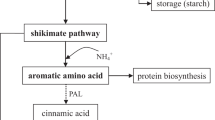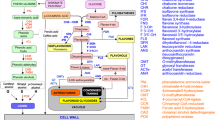Abstract
Key message
While providing either NH4+ or NO3− to Cyclocarya paliurus, a mixture of NO3− and NH4+ at a ratio of 7/3 results in the best combination of plant growth and leaf secondary compound production.
Abstract
Cyclocarya paliurus is a well-known multiple function tree species with leaves that have been used as medicine and nutraceutical foods based on their high content of polyphenolic secondary compounds. Understanding C. paliurus growth and phytochemical accumulation in response to different NO3−/NH4+ ratios is essential to optimize plant growth and secondary compound production. Seedlings of C. paliurus were grown in a growth chamber, and five NO3−/NH4+ ratio treatments were applied. There were significant differences in seedling growth, measured secondary metabolites, and relative gene expression among different NO3−/NH4+ ratio treatments. The highest seedling growth was achieved at the NO3−/NH4+ ratio of 50/50, while the highest induced polyphenol and flavonoid content in plants occurred at NO3−/NH4+ ratios of 100/0 and 0/100 (i.e., when a single nitrogen source was used). C. paliurus leaves were the main sites of the polyphenol and flavonoid accumulation, and the highest yields of measured phytochemicals in leaves were obtained at the NO3−/NH4+ ratio of 70/30. A sole NH4+ or NO3− nutrition promoted related gene expression of the polyphenol and flavonoid biosynthesis, while a significantly positive correlation was detected between the phytochemical contents and related gene expression levels. This study provides a basis for manipulating NO3−/NH4+ ratio to achieve the highest yields of phytochemicals in C. paliurus plantations.




Similar content being viewed by others
References
Argolo ACC, San′Ata AEG, Pletsch M, Coelho LCBB (2004) Antioxidant activity of leaf extracts from Bauhinia monandra. Bioresour Technol 95:229–233
Benavente-García O, Castillo J, Lorente J, Ortuño A, Del Rio JA (2000) Antioxidant activity of phenolics extracted from Olea europaea L. leaves. Food Chem 68:457–462
Borgognone D, Colla G, Rouphael Y, Cardarelli M, Rea E, Schwarz D (2013) Effect of nitrogen form and nutrient solution PH on growth and mineral composition of self-grafted and grafted tomatoes. Sci Hortic 149:61–69
Britto DT, Kronzucker HJ (2002) NH4+ toxicity in higher plants: a critical review. J Plant Physiol 159:567–584
Bybordi A, Tabatabaei J, Ahmadov A (2009) Effects of salinity and NO3: NH4 ratio on yield and quality in canola (Brassica napus L.). Notulae Sci Biol 1:67–72
Cao YN, Fang SZ, Yin ZQ, Fu XX, Shang XL, Yang WX, Yang HM (2017) Chemical fingerprint and multicomponent quantitative analysis for the quality evaluation of Cyclocarya paliurus leaves by HPLC-Q–TOF–MS. Molecules 22:1927
Chang Jie, Liu Dong, Cao Haiqin, Chang Scott X, Wang Xiaoyue, Huang Chengcai, Ge Ying (2010) NO3−/NH4+ ratios affect the growth and N removal ability of Acorus calamus and Iris pseudacorus in a hydroponic system. Aquat Bot 93(4):216–220
Devasagayam TPA, Tilak JC, Boloor KK, Sane KS, Ghaskadbi SS, Lele RD (2004) Free radicals and antioxidants in human health: current status and future prospects. J Assoc Physicians India 52:794–804
Fang SZ, Wang JY, Wei ZY, Zhu ZX (2006) Methods to break seed dormancy in Cyclocarya paliurus (Batal.) Iljinskaja. Sci Hortic 110:305–309
Fang SZ, Yang WX, Chu XL, Shang XL, She CQ, Fu XX (2011) Provenance and temporal variations in selected flavonoids in leaves of Cyclocarya paliurus. Food Chem 124:1382–1386
Faulconnier Y, Boby C, Pires J, Labonne C, Lerous C (2019) Effects of Azgp1(−/−) on mammary gland, adipose tissue and liver gene expression and milk lipid composition in lactating mice. Gene 692:201–207
Guo XR, Zu YG, Tang ZH (2012) Physiological responses of Catharanthus roseusto different nitrogen forms. Acta Physiol Plant 34:589–598
Hakulinen J, Julkunen-Tiitto R, Tahvanainen J (1995) Does nitrogen fertilization have an impact on the trade-off between willow growth and defensive secondary metabolism? Trees Struct Funct 9:235–240
Herms DA, Mattson WJ (1992) The dilemma of plants: to grow or defend. Q Rev Biol 67:283–335
Karimi E, Oskoueian E, Hendra R, Jaafar HZE (2010) Evaluation of Crocus sativus L. stigma phenolic and flavonoid compounds and its antioxidant activity. Molecules 15(9):6244–6256
Kováčik J, Bačkor M (2007) Changes of phenolic metabolism and oxidative status in nitrogen-deficient Matricaria chamomilla plants. Plant Soil 297:255–265
La GX, Yang TG, Fang P, Guo HX, Hao X, Huang SM (2013) Effect of NH4+/NO3- ratios on the growth and bolting stem glucosinolate content of Chinese kale (Brassica alboglabra L.H. Bailey). Aust J Crop Sci 7(5):618–624
Lee EJ, Paek KY (2012) Effect of nitrogen source on biomass and bioactive compound production in submerged cultures of Eleutherococcus koreanum Nakai adventitious roots. Biotechnol Prog 28:508–514
Li FM, Tan J, Nie SP, Dong CJ, Li C (2006) The study on determination methods of total flavonoids in Cyclocarya paliurus. Food Sci Technol 4:34–37 ((in Chinese))
Liu MY, Burgos A, Zhang QF, Tang DD, Shi YZ, Ma LF, Yi XY, Ruan JY (2017) Analyses of transcriptome profiles and selected metabolites unravel the metabolic response to NH4+ and NO3− as signaling molecules in tea plant (Camellia sinensis L.). Sci Hortic 218:293–303
Liu Y, Fang SZ, Yang WX, Shang XL, Fu XX (2018) Light quality affects flavonoid production and related gene expression in Cyclocarya paliurus. J Photochem Photobiol B Biol 179:66–73
He CE, Lu LL, Jin Y, Wei JH, Christie P (2013) Effects of nitrogen on root development and contents of bioactive compounds in Salvia miltiorrhiza Bunge. Crop Sci 53:2028–2203
Naik PM, Manohar SH, Murthy HN (2011) Effects of macro elements and nitrogen source on biomass accumulation and bacoside A production from adventitious shoot cultures of Bacopa monnieri (L.). Acta Physiol Plant 33:1553–1557
Ruan Jianyun, Gerendás Jóska, Härdter Rolf, Sattelmacher Burkhard (2007) Effect of nitrogen form and root-zone pH on growth and nitrogen uptake of tea (Camellia sinensis) plants. Ann Bot 99(2):301–310
Schmidt S, Zietz M, Schreiner M, Rohn S, Kroh LW, Krumbein A (2010) Genotypic and climatic influence on the concentration and composition of flavonoids in kales (Brassica oleracea var. sabellica). Food Chem 119:1293–1299
Stamp N (2003) Out of the quagmire of plant defense hypotheses. Q Rev Biol 78:23–55
Stamp N (2004) Can the growth—differentiation balance hypothesis be tested rigorously? Oikos 107:439–448
Sultana B, Anwar F (2008) Flavonoids (kaempferol, quercetin, myricetin) contents of selected fruits, vegetables and medicinal plants. Food Chem 108:879–884
Tabatabaei SJ, Yusefi M, Hajiloo J (2008) Effects of shading and NO3: NH4 ratio on the yield, quality and N metabolism in strawberry. Sci Hortic 116:264–272
Taiz L, Zeiger E (2006) Plant physiology, 4th edn. Sinauer Associates Inc, Sunderland
Tang ZH, Liu YJ, Guo XR, Zu YG (2011) The combined effects of salinity and nitrogen forms on Catharanthus roseus: the role of internal ammonium and free amino acids during salt stress. J Plant Nutr Soil Sci 174:135–144
Wang JW, Tan RX (2002) Artemisinin production in Artemisia annua hairy root cultures with improved growth by altering the nitrogen source in the medium. Biotechnol Lett 24:1153–1156
Wang ZK, Chen ZY, Xu ZH, Fu XX (2019) Effects of phosphate-solubilizing bacteria and N2-fixing bacteria on nutrient uptake, plant growth, and bioactive compound accumulation in Cyclocarya paliurus (Batal.) Iljinskaja. Forests 10:772
Xie JH, Xie MY, Nie SP, Shen MY, Wang YX, Li C (2010) Isolation, chemical composition and antioxidant activities of a water-soluble polysaccharide from Cyclocarya paliurus (Batal.) Iljinskaja. Food Chem 119:1626–1632
Xie PJ, Huang LX, Zhang CH, Zhang YL (2015) Phenolic compositions, and antioxidant performance of olive leaf and fruit (Olea europaea L.) extracts and their structure–activity relationships. J Funct Food 16:460–471
Xie JH, Wang ZJ, Shen MY, Nie SP, Xie MY (2016) Sulfated modification, characterization and antioxidant activities of polysaccharide from Cyclocarya paliurus. Food Hydrocolloids 53:7–15
Yang ZW, Ouyang KH, Zhao J, Chen H, Xiong L, Wang WJ (2016) Structural characterization and hypolipidemic effect of Cyclocarya paliurus polysaccharide in rat. Int J Biol Macromol 91:1073–1080
Zaghdoud C, Carvajal M, Moreno DA, Ferchichi A, del Carmen M-B (2016) Health-promoting compounds of broccoli (Brassica oleracea L. var. italica) plants as affected by nitrogen fertilisation in projected future climatic change environments. J Sci Food Agric 96:392–403
Zhang CX, Meng S, Li YM, Su L, Zhao Z (2016a) Nitrogen uptake and allocation in Populus simonii in different seasons supplied with isotopically labeled ammonium or nitrate. Trees-Struct Funct 30:2011–2018
Zhang G, Pang T, Wang SS, Li WJ, Yang LY, Li JY, Ma JH, Gong M (2016b) Regulation of different growth temperatures on flavonoids content and their metabolic pathways in tobacco leaves. Genom Appl Biol 35:3527–3537 ((in Chinese))
Zhou JJ, Theodoulou FL, Muldin I, Ingemarsson B, Miller AJ (1998) Cloning and functional characterization of a Brassica napus transporter that is able to transport nitrate and histidine. J Biol Chem 273:12017–12023
Zhou MM, Lin Y, Fang SZ, Liu Y, Shang XL (2019) Phytochemical content and antioxidant activity in aqueous extracts of Cyclocarya paliurus leaves collected from different populations. Peer J 7:e6492
Zhu ZB, Yu MM, Chen YH, Guo QS, Zhang LX, Shi HZ, Liu L (2014) Effects of ammonium to nitrate ratio on growth, nitrogen metabolism, photosynthetic efficiency and bioactive phytochemical production of Prunella vulgaris. Pharm Biol 52:1518–1525
Acknowledgements
We acknowledge financial support from the National Natural Science Foundation of China (Project numbers: 31470637, 31270673), a project funded by the Priority Academic Program Development of Jiangsu Higher Education Institutions (PAPD) and the Doctorate Fellowship Foundation of Nanjing Forestry University.
Author information
Authors and Affiliations
Corresponding author
Ethics declarations
Conflict of interest
The authors declare that they have no conflict of interest.
Additional information
Communicated by Peterson.
Publisher's Note
Springer Nature remains neutral with regard to jurisdictional claims in published maps and institutional affiliations.
Supplementary Information
Below is the link to the electronic supplementary material.
Rights and permissions
About this article
Cite this article
Qin, J., Yue, X., Ling, Y. et al. Nitrogen form and ratio impact phenolic accumulation and relative gene expression in Cyclocarya paliurus. Trees 35, 685–696 (2021). https://doi.org/10.1007/s00468-020-02068-6
Received:
Accepted:
Published:
Issue Date:
DOI: https://doi.org/10.1007/s00468-020-02068-6




